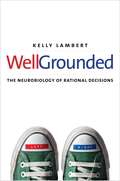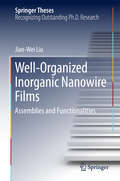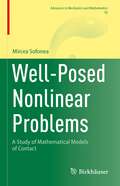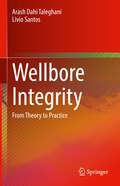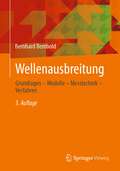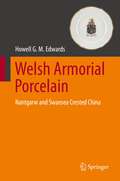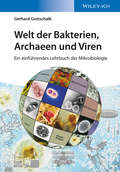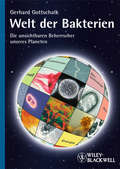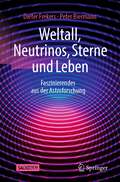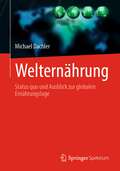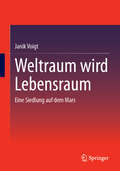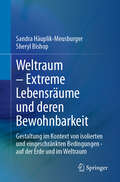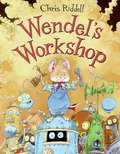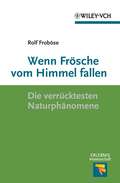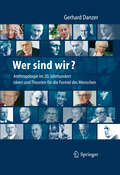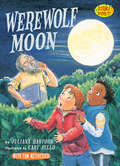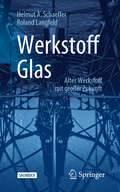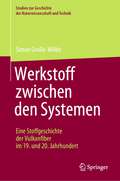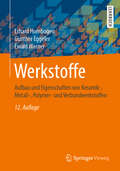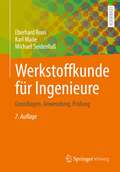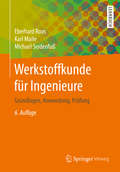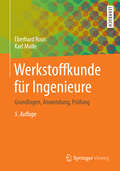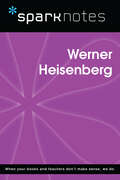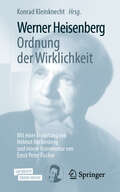- Table View
- List View
Well-Grounded: The Neurobiology of Rational Decisions
by Kelly LambertA neuroscientist reveals unique aspects of decision making and the best strategies for protecting and enhancing the brain’s ability to navigate life’s uncertainties Contingency calculations—the ability to predict the outcomes of decisions and actions—are critical for survival and success. Our amazing brains continually process past and current experiences to enable us to make the most adaptive choices. But when the brain’s information systems are compromised—by such varying conditions as drug addiction, poverty, mental illness, or even privilege—we can lose the ability to arrive at informed decisions. In this engaging book, behavioral neuroscientist Kelly Lambert explores a variety of the modern factors that can lead to warped neural processing, or distorted realities she terms “brain bubbles.” Individuals who define success in terms of creature comforts and immediate gratification, for instance, may interact less with the physical and social world and thereby dull their ability to imagine varied contingency scenarios. The author underscores how continuous, meaningful, and well-grounded experiences are required if we are to make the best decisions throughout our lives.
Well-Organized Inorganic Nanowire Films
by Jian-Wei LiuThis thesis presents the latest findings on macroscopic-scale nanowire thin films composed of integrated nanowires. It introduces readers to essential synthesis and assembly strategies for the design and fabrication of high-quality nanowire thin films, and discusses their underlying principles in detail. The book highlights examples specific to well-aligned nanowire systems, and explores the applications of nanowire systems, including memory devices, flexible transparent electrodes, etc. The book offers a valuable resource for researchers and graduate students working in materials science, especially in nanowire device fabrication.
Well-Posed Nonlinear Problems: A Study of Mathematical Models of Contact (Advances in Mechanics and Mathematics #50)
by Mircea SofoneaThis monograph presents an original method to unify the mathematical theories of well-posed problems and contact mechanics. The author uses a new concept called the Tykhonov triple to develop a well-posedness theory in which every convergence result can be interpreted as a well-posedness result. This will be useful for studying a wide class of nonlinear problems, including fixed-point problems, inequality problems, and optimal control problems. Another unique feature of the manuscript is the unitary treatment of mathematical models of contact, for which new variational formulations and convergence results are presented. Well-Posed Nonlinear Problems will be a valuable resource for PhD students and researchers studying contact problems. It will also be accessible to interested researchers in related fields, such as physics, mechanics, engineering, and operations research.
Wellbore Integrity: From Theory to Practice
by Arash Dahi Taleghani Livio SantosThere have been concerns about the integrity of thousands of wells drilled worldwide for different purposes ranging from oil and gas to geological carbon sequestration. This is the first book to integrate different aspects of wellbore integrity into a single volume. It looks at the energy sector's green wave movement by expanding an important topic for practitioners, regulators, and students. It is an area where petroleum and subsurface engineers will increasingly need to be involved in the future to address growing expectations regarding environmental impacts and sustainability. Coverage also includes recent developments in regulations and R&D with indications on emerging areas.Wellbore Integrity: From Theory to Practice will be a valuable resource for practicing engineers and students working on problems related to subsurface energy, subsurface disposals, and environmental impacts of oil and gas wells. In parallel, it will be a valuable reference for engineers and scientists interested in repurposing existing wells for carbon sequestration or geothermal purposes.
Wellenausbreitung: Grundlagen – Modelle – Messtechnik – Verfahren
by Bernhard RemboldDas Lehrbuch vermittelt dem Leser grundlegende Kenntnisse über das, was zwischen Sende- und Empfangsantenne geschieht, da sie für eine plangemäße Funktion entscheidend sind. Die Wellenausbreitung bestimmt maßgebend die Übertragungsverfahren in der Funkkommunikation und beeinflusst in vielen HF-Anwendungen die Systemauslegung. Ziel des Buches ist, dem Leser diese Kenntnisse zu vermitteln sowie ihn in die Lage zu versetzen, Probleme und Möglichkeiten in Zusammenhang mit der Wellenausbreitung zu verstehen und beurteilen zu können.
Welsh Armorial Porcelain: Nantgarw and Swansea Crested China
by Howell G. EdwardsArmorial porcelains comprised the output of most European ceramics factories in the 18th and 19th Centuries in response to the large quantity of armorial porcelain services that were being imported from China bearing the coats of arms and crests of aristocratic families. Whereas these armorial services have been identified and covered for most porcelain manufactories the information relevant to their production by the two relatively short-lived Nantgarw and Swansea China Works has not been addressed as a theme until now. As an integral component of the holistic forensic appraisal of porcelain, a functional and decorative artwork manifestly part of our cultural heritage and its ongoing preservation , the recording and identification of such artefacts is material for the future establishment of a database of factory production . The Nantgarw and Swansea factories only operated for a limited period in the second decade of the 19th Century and their porcelains were much appreciated for their high quality and desirability by Georgian households. Today, examples are to be found in many museums and ceramics collections and continue to excite the interest of specialists and the general public . This text provides the first comprehensive assessment of armorial porcelains from these two factories and the methodology and procedure for the identification of unknown armorial bearings and crests is illustrated; individual bearings are discussed in detail and existing incorrect assignments in the literature are re-appraised. The difficulties in attribution of armorial heraldic achievements that are only minimally depicted are considered and directions for further studies using historical documentation are invoked. This book therefore fills a currently existing gap in the ceramics literature of the 19th Century.
Welt der Bakterien, Archaeen und Viren: Ein einführendes Lehrbuch der Mikrobiologie
by Gerhard GottschalkZeitgemasses Wissen in Lekture- und in Lehrbuchform. Gerhard Gottschalk vermittelt die Mikrobiologie in ihrer ganzen Breite. In 12 Teilen mit jeweils mehreren Kapiteln wird die Mikrobiologie dem Leser auf sehr verstandliche Weise nahergebracht. <P><P>Jedes Kapitel besteht aus einer leicht zu lesenden Beschreibung und darauf abgestimmter Lerneinheit samt Fragenkatalog. Daruber hinaus enthalten die meisten Kapitel Beitrage beruhmter Wissenschaftler auf dem entsprechenden Gebiet. Historische Durchbruche werden beschrieben und so den Studierenden Einblicke in Denk- und Planungsstrukturen von wissenschaftlichem Arbeiten vermittelt. So beschreibt beispielsweise Stefan Hell seine 2014 mit dem Nobelpreis gekronte STED-Mikroskopie. Alle wichtigen Gebiete der Mikrobiologie, von der Evolution uber den mikrobiellen Stoffwechsel und die technischen Anwendungen bis hin zum Gentransfer, zu den Endosymbionten und den Pathogenen werden abgedeckt. Auch wird den Archaea und den Viren entsprechend ihrer enormen Bedeutung ein eigener Teil gewidmet. Das Buch ist ein perfekter Begleiter fur die einfuhrende Vorlesung "Allgemeine Mikrobiologie" sowie ein hervorragender Studienbegleiter fur alle Naturwissenschaftler und Ingenieure, die Mikrobiologie als Nebenfach belegen.
Welt der Bakterien: Die unsichtbaren Beherrscher unseres Planeten
by Gerhard GottschalkWritten in dialog form, Gerhard Gottschalk's book provides surprising insights into the amazing world of bacteria. These microorganisms have changed the Earth more than any other life form and turned it into an inhabitable planet. Did you know, for example, that the human body contains more bacteria cells than human ones? Or that in each animal and plant cell the remains of former symbiotic bacteria maintain the metabolism? But bacteria also have their negative aspects: they cause illnesses and produce the strongest toxins known to mankind. Backed by more than 45 contributions from famous international scientists written especially for this book.
Weltall, Neutrinos, Sterne und Leben: Faszinierendes aus der Astroforschung
by Dieter Frekers Peter BiermannDieses Sachbuch nimmt Sie mit auf eine Reise durch kosmische Epochen, beginnend mit dem Big Bang und der kosmischen Inflation. Es taucht dann ein ins Frühe Universum und die frühe Nukleosynthese und schildert, warum diese Phase bereits nach 10 Minuten wieder beendet war. Das Buch beschreibt, wie es zur kosmischen Mikrowellenstrahlung kam und welche erstaunlichen Informationen zur heutigen Zeit daraus extrahiert werden können. Es erklärt, wie die Elemente in Supernova-Explosionen entstehen und wie man mit solchen Ereignissen die Expansion des Universums bestimmt. Auch unsere Sonne und ihr voraussichtliches Schicksal werden im Detail beschrieben. Dabei werden komplexe Themen wie Relativität, Neutronensterne, Schwarze Löcher, Gravitationswellen, kosmische Strahlung und Dunkle Materie allgemeinverständlich erläutert. Darüber hinaus beschäftigt sich dieses Buch mit der Frage, wie Leben entstehen konnte, und was Neutrinos mit der Synthese von Lebensformen zu tun haben. Einige der behandelten Themen sind eingebunden in einen geschichtlichen, teilweise bis ins 18. Jh. zurückreichenden Zusammenhang, wobei die markantesten Einzelleistungen der beteiligten Wissenschaftlerinnen und Wissenschaftler in besonderer Weise herausgestellt sind. Das Buch entstand aus dem an der Universität Münster jährlich stattfindenden „Münsteraner Astroseminar“ und richtet sich an ein interessiertes Publikum ohne besondere Vorkenntnisse. Leserinnen und Leser mit Interesse an der Entstehung und Entwicklung des Kosmos werden in diesem Buch aktuelle und allgemeinverständliche Einblicke in die Forschung und die physikalischen Zusammenhänge finden.
Welternährung: Status quo und Ausblick zur globalen Ernährungslage
by Michael DachlerIst die globale Nahrungsmittelproduktion ausreichend, um die Ernährungssicherung für alle Menschen zu gewährleisten? Und kann sie es auch in Zukunft sein? Welcher Zusammenhang besteht zwischen Landwirtschaft und Klimawandel? Wo liegen die Ursachen für Fehlernährung und in welchen Ländern herrschen Mangel oder sogar Überfluss? Ausgehend von der erwarteten Zunahme der Weltbevölkerung beschreibt dieses Fachbuch die derzeitige Ernährungslage, die Ernährungserfordernisse (Kalorien- und Proteinbedarf) und listet unterschiedliche Methoden auf, die den Grad der Unterversorgung bestimmen, wie z. B. den Welthungerindex. Daran anschließend wird der Selbstversorgungsgrad verschiedener Länder vorgestellt und die Gefahren und Chancen von Landgrabbing erörtert.Ein besonderer Fokus liegt auf den Produktionsmitteln der Nahrungsmittelerzeugung und deren zukünftige Entwicklung: Boden, Klima, Wasser, Düngung, Pflanzenschutz, Mechanisierung der Landwirtschaft. Zudem werden wichtige pflanzliche und tierische Nahrungsmittel nach globalen Produktionsmengen vorgestellt sowie unterschiedliche landwirtschaftliche Produktionsmethoden beschrieben. Fachkräfte im Bereich der Entwicklungszusammenarbeit, in NGOs, internationalen Organisationen und ernährungspolitischen Verbänden bietet dieses Fachbuch eine detaillierte Zusammenstellung an Zahlen, Daten und Fakten zur globalen Ernährungslage. Studierende der Agrar- und Ernährungswissenschaften erhalten Einsicht in die komplexen Zusammenhänge zwischen wirtschaftlicher und demografischer Entwicklung, Agrarsystemen und internationaler Ernährungssicherheit.
Weltraum wird Lebensraum: Eine Siedlung auf dem Mars
by Janik VoigtExtremwetter, Überbevölkerung, Naturzerstörung: Zukunftsszenarien, die den Planeten Erde als unbewohnbar erscheinen lassen sind nicht länger nur noch Material für Science-Fiction-Romane. Welche Optionen bleiben der Menschheit, wenn sie sich ihrer eigenen Lebensgrundlage beraubt hat? Ist ein Szenario, in dem wir uns einen neuen Heimatplaneten erschließen, konkret umsetzbar oder ein reines Fantasiegespinst? In dem vorliegenden Buch geht es darum, den Mars auf seine Eignung für eine menschliche Besiedlung hin zu untersuchen. Insbesondere die ganz konkrete Frage, ob die Errichtung von Habitaten auf dem Mars möglich wäre, steht im Vordergrund. Um diese Frage zu beantworten, werden die geologischen wie auch die natürlichen Bedingungen analysiert und es wird aufgezeigt, welche Konsequenzen diese für etwaige Bauvorhaben auf dem Mars haben. Außerdem wird unter Bezug auf bereits erfolgte Experimente und Expeditionen erörtert, welche Eigenschaften ein Habitat erfüllen muss, damit der Mensch langfristig ein gutes Leben außerhalb der Erde führen kann. Die Überlegungen fließen zusammen in einem eigenen Entwurf einer Marskolonie, wie sie sich konkret umsetzen ließe. Das Buch bietet einen Überblick über die einschlägigen Überlegungen zu einer potentiellen Kolonisierung des Mars und eignet sich damit als lockerer Einstieg in dieses komplexe Thema. Anschauliche Illustrationen beflügeln die Fantasie und machen deutlich, dass die Besiedelung des Mars nicht nur eine Angelegenheit für Romanciers, sondern auch für Architekt:innen und andere Visionäre ist.
Weltraum – Extreme Lebensräume und deren Bewohnbarkeit: Gestaltung im Kontext von isolierten und eingeschränkten Bedingungen - auf der Erde und im Weltraum
by Sandra Häuplik-Meusburger Sheryl BishopDieses Buch erforscht kreative Lösungen für die einzigartigen Herausforderungen, die mit der Gestaltung bewohnbarer Räume in extra-terrestrischen Umgebungen verbunden sind. Ziel ist es, einen konstruktiven Dialog zwischen den Forschern und Planern zukünftiger (Weltraum-)Lebensräume zu fördern. Die Autoren untersuchen die verschiedenen Konzepte des Begriffs Habitability [auf Deutsch Bewohnbarkeit] aus der Perspektive der Bewohner sowie der Planer und Sozialwissenschaften. Das Buch gibt einen Überblick über die Entwicklung und die Fortschritte in der Gestaltung von Lebensräumen für bemannte Raumfahrzeuge und -habitate, und inkludiert auch analoge Forschungs- und Simulationseinrichtungen in extremen Umgebungen auf der Erde. Es zeigt auf, wie verschiedene Konzepte der Habitabilität gestalterisch umgesetzt wurden und welche noch fehlen. Der Schwerpunkt dieses Buches liegt auf der Identifizierung der wesentlichen Faktoren und kreativer Lösungen zur Schaffung von Lebensräumen, in denen sich Menschen wohlfühlen. Ausgewählte Aspekte werden vor einem sozial-räumlichen fachlichen Hintergrund diskutiert und mögliche Anwendungen aufgezeigt. Human Factors und Habitability Design sind wichtige Themen für jedwede Arbeits- und Lebensräume. Für die bemannte Erforschung des Weltraums sind sie von entscheidender Bedeutung. Zwar wurden menschliche Faktoren und bestimmte Aspekte der Bewohnbarkeit in den Entwurfsprozess von bemannten Raumfahrzeugen integriert, doch besteht die Dringlichkeit von der reinen funktionalen Überlebensfähigkeit, in ein den Menschen unterstützendes Design überzugehen. Seit einigen Jahren anerkennt die NASA das Risiko eines inkompatiblen Fahrzeug- oder Habitatdesigns als ein Hauptrisiko für die menschliche Gesundheit und Leistungsfähigkeit im Weltraum an. Die Bewohnbarkeit und die menschlichen Faktoren werden für die Gestaltung künftiger langfristiger und kommerzieller Weltraumeinrichtungen noch wichtiger werden, wenn größere und unterschiedlichere Gruppen Lebensräume außerhalb der Erde nutzen. Das Buch wird nicht nur Personen und Organisationen zugutekommen, die für bemannte Raumfahrtmissionen und Missionssimulatoren verantwortlich sind, sondern bietet auch relevante Informationen für Gestalter terrestrischer rauer Umgebungen (z. B. abgelegene Betriebs- und Forschungseinrichtungen, Krankenhäuser, Gefängnisse, Produktionsstätten). Darüber hinaus werden Erkenntnisse über die sozio-räumliche Beziehung vorgestellt, die für Sozialwissenschaftler, Ingenieure und Architekten im Allgemeinen von Interesse sind. Inhaltsverzeichnis Kurz : 1. Einleitung.- 2. Habitability / Bewohnbarkeit: Vom ORT zum (Lebens) RAUM.- 3. Bewohnbarkeit als (Lebens) RAUM.- 4. Rezension: Studien zur Bewohnbarkeit und Architektur von Mockups und simulierten Umgebungen.- 5. Rezension: Studien zur Bewohnbarkeit und Architektur in In-Situ-Umgebungen.- 6. Projektionen.- 7. Blick in die Zukunft: Wie man eine Blechbüchse in ein Zuhause verwandelt: Lösungen für ausgewählte Dimensionen der (sozialräumlichen) Bewohnbarkeit.
Wendel's Workshop
by Chris RiddellWendel is far too busy inventing things to keep his workshop tidy. So if one of his inventions doesn't work, Wendel just tosses it onto the scrap heap and starts over. Then one day he invents the magnificent Wendelbot--a mighty robot that cleans and cleans and doesn't stop. Soon poor Wendel finds himself thrown onto the scrap heap! How will Wendel win back his workshop? Let the robot battle begin! From the award-winning and always imaginative Chris Riddell comes a wonderfully funny, action-packed story full of surprises and extraordinary inventions.
Wenn Frösche vom Himmel fallen: Die verrücktesten Naturphänomene (Erlebnis Wissenschaft)
by Rolf FroböseAs incredible as it may sound, nature is still unbeatable and provides us with the most amazing inventions and phenomena, beyond human imagination. Bacteria that produce plastic or electricity, for example, or natural rocket propulsion or algae that may meet the energy needs of future generations with their supplies of hydrogen. How is it that frogs and fish fall from the sky, how does the dust from the Sahara reach the Caribbean and what lies behind the mysteries of the deep-sea methane oases? Yet nature has also invented modern technologies. A natural solar power plant, for example, provides an Antarctic lake with an agreeable water temperature, and the first functioning nuclear reactor existed in Africa two billion years ago. Nature even created the very first laser. Researchers around the globe are increasingly searching for ways of using nature's inventions for developing new products and concepts. One case in point are extremophile bacteria, which thrive at the baking temperature of 140 degrees Celsius. The resulting enzymes should prove fruitful in chemistry. But also chemosensors, which work like a dog's nose, and bulletproof jackets based on spiders' webs are visions that could profit from evolution's treasure trove.
Wenn das Gelbe vom Ei blau macht: Spruche mit versteckter Chemie (Erlebnis Wissenschaft)
by Georg SchwedtWer war nicht schon mal "Feuer und Flamme" fur eine neue Idee? Und musste sich sagen lassen: "Das ist doch alles kalter Kaffee!" Dann ist meistens "Hopfen und Malz verloren", und es nutzt auch nichts, dem Gesprachspartner "Honig ums Maul zu schmieren", denn er wird immer wieder ein "Haar in der Suppe" finden. Solche Spruche kennt jeder und benutzt sie, ohne zu wissen, was eigentlich dahintersteckt. Das ergibt ganz klar einen neuen Fall fur Georg Schwedt, den chemischen Detektiv, der immer wieder aufs Neue enthullt, wieviel Chemie in unserem Alltag steckt - und eben auch in unserer Alltagssprache. Seine Ermittlungsergebnisse stellt er uns exklusiv zur Verfugung: Von A wie "In den sauren Apfel bei?en" bis Z wie "Nicht aus Zucker sein" erfahren wir mehr uber Geschichte und Verwendung solcher Redensarten und lernen nebenbei eine Menge uber die darin versteckte Chemie.
Wer sind wir? Auf der Suche nach der Formel des Menschen
by Gerhard DanzerAnthropologie ist der Versuch des Menschen, nach seinem Wesen und seiner Natur zu fragen sowie seine Herkunft und Möglichkeiten zu ergründen. Während sich Philosophen schon immer mit diesem Thema beschäftigt haben, sind im 20. Jahrhundert viele Disziplinen hinzugekommen. Der Autor beschreibt anhand von 35 biografischen und werkanalytischen Erörterungen, wie sich Ärzte und Philosophen im 20. Jahrhundert auf die Suche nach der "Formel des Menschen" begeben haben. Dabei setzt er sich mit den verschiedenen Denkrichtungen kritisch auseinander.
Werewolf Moon (Science Solves It!)
by Juliana HanfordCould the new neighbor be a werewolf? Jake has to find out - before the full moon strikes and it's too late.
Werkstoff Glas: Alter Werkstoff mit großer Zukunft (Technik im Fokus)
by Helmut A. Schaeffer Roland LangfeldWas ist Glas? Wie wird es hergestellt? Wo wird Glas eingesetzt? Hat Glas eine Zukunft? Die Autoren sind Experten ihres Faches. Trotzdem gelingt es ihnen, informativ und doch unterhaltsam Antworten auf diese Fragen zu geben. An ausgewählten Beispielen erläutern sie die vielfältigen Anwendungen von Glas. Und sie vermitteln, wie die physikalischen und chemischen Eigenschaften dieses Werkstoffes zur Entwicklung technischer, industriell gefertigter Produkte führen. So ermöglicht etwa die bis ins Extrem gesteigerte Lichtdurchlässigkeit einer Glasfaser die heutige Telekommunikation und das Internet. Besonders dünnes Glas, das zusätzlich verfestigt ist, wird für Bildschirme von Fernsehern, Laptops und Mobiltelefonen eingesetzt, Glaswerkstoffe mit thermischer Nullausdehnung sind der Werkstoff der Wahl für Teleskopspiegelträger und Kochflächen.
Werkstoff zwischen den Systemen – Eine Stoffgeschichte der Vulkanfiber im 19. und 20. Jahrhundert (Studien zur Geschichte der Naturwissenschaft und Technik)
by Simon Große-WildeVulkanfiber ist einer der ältesten, industriell hergestellten Kunststoffe und wird seit über 100 Jahren in Deutschland produziert. Dennoch ist die Geschichte dieses Biopolymers, das als Trägermaterial für Schleifscheiben und Endloslaminate dient, aus dem Dichtungsringe und Stanzteile für den Maschinenbau oder die Elektroindustrie hergestellt werden, weitgehend unbekannt. Dabei besitzt Vulkanfiber nicht nur interessante Materialeigenschaften, sondern wird auch aus nachwachsenden Rohstoffen hergestellt und ist vollständig biologisch abbaubar.Warum aber entwickelte sich die Vulkanfiber zu einem nahezu unbekannten Nischenwerkstoff? Um diese Frage zu beantworten, untersucht die Studie die Geschichte der Vulkanfiber im Deutschland des 19. und 20. Jahrhunderts. Dabei begleitet die Erzählung die Vulkanfiber durch die verschiedenen politischen, ökonomischen, gesellschaftlichen und kulturellen Systeme und erforscht die Adaptionsprozesse der Vulkanfiber an diese Systeme und umgekehrt. Als technisches Artefakt ist die Vulkanfiber ein Produkt und Teil unserer materiellen Kultur, sodass die vorliegende Studie sowohl die Produktions-, als auch die Konsum- und Kulturgeschichte der Vulkanfiber untersucht.
Werkstoffe: Aufbau und Eigenschaften von Keramik-, Metall-, Polymer- und Verbundwerkstoffen (Springer-Lehrbuch)
by Erhard Hornbogen Gunther Eggeler Ewald WernerDas Standardwerk zur Werkstoffkunde erfährt seit über 40 Jahren regen Zuspruch. Ausgehend von einer einheitlichen werkstoffwissenschaftlichen Darstellung der Mikrostrukturen von Werkstoffen, ihren Bildungsbedingungen und den sich daraus ergebenden Stoffeigenschaften, werden die keramischen, metallischen sowie die Polymer- und Verbundwerkstoffe systematisch und praxisnah behandelt. Dabei werden neue Entwicklungen berücksichtigt, wie z.B. Supraleiter, Formgedächtnislegierungen, Biopolymere, Piezoelektrika und Nanostrukturen. Ebenso behandelt werden zahlreiche Aspekte der Werkstofftechnik sowie Stoffkreisläufe und Nachhaltigkeit.Für die 12. Auflage wurde das Zahlen- und Bildmaterial aktualisiert, um gegenwärtige Entwicklungen zu berücksichtigen. Zudem wurde das Buch in ein neues Layout überführt, um die Lesbarkeit der elektronischen Version auf verschiedenen Endgeräten zu verbessern. Die ZielgruppenDas Buch bietet für Studierende der Ingenieurwissenschaften an Universitäten und Fachhochschulen eine kompakte und systematische Darstellung der Werkstoffkunde und Werkstoffwissenschaft auf neuestem Stand.
Werkstoffkunde für Ingenieure: Grundlagen, Anwendung, Prüfung
by Eberhard Roos Karl Maile Michael SeidenfußNach einer Einführung in die Grundlagen der Werkstoffwissenschaft werden in diesem gut eingeführten Lehrbuch die Anwendungsaspekte der Werkstoffe behandelt. Insbesondere die mechanischen Eigenschaften und das Verhalten von Werkstoffgruppen unter unterschiedlichen Umgebungs- und Belastungsbedingungen werden erläutert. Ein besonderer Schwerpunkt liegt auf der Darstellung der technischen Gebrauchseigenschaften der Werkstoffe. So werden für ausgewählte Werkstoffe die Materialkonstanten und Festigkeitskennwerte angegeben. Behandelt werden Stähle und Stahllegierungen für besondere Anwendungen, Leichtmetalle, Nichteisenmetalle, Kunststoffe, Keramiken und Verbundwerkstoffe.Weitere Aspekte des Buches sind die Darstellungen der Möglichkeiten der zerstörenden und zerstörungsfreien Werkstoffprüfung. Eingegangen wird auf die spezifischen Schädigungsmechanismen der unterschiedlichen Werkstoffgruppen und deren Gesetzmäßigkeiten. Dabei bilden Korrosion und Verschleiß einen besonderen Schwerpunkt. Verständnisfragen zu jedem Kapitel runden das Buch ab. Die vorliegende Auflage wurde umfassend überarbeitet, die Inhalte wurden an den fortgeschrittenen Stand der Technik und des Wissens angepasst. Die zitierten Normen wurden an den aktuellen Stand mit den z. Zt. gültigen Werkstoffdaten und -bezeichnungen angepasst. Werkstofftechnische Entwicklungen mit einem besonderen Zusammenhang wurden mit aktuellen technischen Problemstellungen vertieft, besonders hervorgehoben oder erweitert, z. B. der Einfluss von Wasserstoff auf das Werkstoffverhalten von Stählen.
Werkstoffkunde für Ingenieure: Grundlagen, Anwendung, Prüfung
by Eberhard Roos Karl Maile Michael SeidenfußNach einer Einführung in die Grundlagen der Werkstoffwissenschaft werden in diesem gut eingeführten Lehrbuch die Anwendungsaspekte der Werkstoffe behandelt. Insbesondere die mechanischen Eigenschaften und das Verhalten von Werkstoffgruppen unter unterschiedlichen Umgebungs- und Belastungsbedingungen werden erläutert. Ein besonderer Schwerpunkt liegt auf der Darstellung der technischen Gebrauchseigenschaften der Werkstoffe. So werden für ausgewählte Werkstoffe die Materialkonstanten und Festigkeitskennwerte angegeben. Behandelt werden Stähle und Stahllegierungen für besondere Anwendungen, Leichtmetalle, Nichteisenmetalle, Kunststoffe, Keramiken und Verbundwerkstoffe.Weitere Aspekte des Buches sind die Darstellungen der Möglichkeiten der zerstörenden und zerstörungsfreien Werkstoffprüfung. Eingegangen wird auf die spezifischen Schädigungsmechanismen der unterschiedlichen Werkstoffgruppen und deren Gesetzmäßigkeiten. Dabei bilden Korrosion und Verschleiß einen besonderen Schwerpunkt. Verständnisfragen zu jedem Kapitel runden das Buch ab.Die ZielgruppenIn erster Linie Studierende des Maschinenbaus, der Fahrzeug- und Motorentechnik sowie artverwandter Ingenieurstudiengänge. Weiterhin Studierende aus den Natur-und Wirtschaftswissenschaften. Das Buch ist auch bestens geeignet als berufsbegleitendes Nachschlagewerk.
Werkstoffkunde für Ingenieure: Grundlagen, Anwendung, Prüfung (Springer-Lehrbuch)
by Eberhard Roos Karl MaileDer InhaltNach einer Einführung in die Grundlagen der Werkstoffwissenschaft werden die Anwendungsaspekte behandelt. Insbesondere die Gesetzmäßigkeiten der mechanischen Eigenschaften und das Verhalten von Werkstoffgruppen unter unterschiedlichen Umgebungs- und Belastungsbedingungen werden erläutert. Ein besonderer Schwerpunkt liegt auf der Darstellung der technischen Gebrauchseigenschaften der Werkstoffe. Für die gebräuchlichsten Werkstoffe werden die elastischen Konstanten und Festigkeitskennwerte angegeben.Angesprochen werden die Möglichkeiten der Werkstoffprüfung, wobei die zerstörungsfreie Werkstoffprüfung einbezogen wurde.Behandelt werden Stähle, Stahllegierungen für besondere Anwendungen, Leichtmetalle, Nichteisenmetalle, Kunststoffe, Keramiken und Verbundwerkstoffe im Hinblick auf den gesamten Bereich der technischen Anwendung. Die Schädigung der unterschiedlichen Werkstoffgruppen durch Korrosion und Verschleiß wird diskutiert. Verständnisfragen zu jedem Kapitel runden das Buch ab.Die ZielgruppenDas Buch wurde für Studierende der Fächer Maschinenbau, Fahrzeug- und Motorentechnik sowie artverwandte Ingenieursstudiengänge konzipiert. Aufgrund seines leicht verständlichen Aufbaus bietet es aber auch Studierenden aus den Natur- und Wirtschaftswissenschaften die Möglichkeit sich mit werkstoffkundlichen Fragestellungen auseinanderzusetzen. Es eignet sich ebenso als berufsbegleitendes Nachschlagewerk.Die AutorenProf. Dr.-Ing. habil. Eberhard Roos wurde, nach verschiedenen Stationen in der Industrie, 1995 zum Direktor der Materialprüfungsanstalt (MPA) der Universität Stuttgart berufen. Die Schwerpunkte in der Lehre waren Materialprüfung, Werkstoffkunde und Festigkeitslehre.Prof. Dr.-Ing. habil. Karl Maile ist seit 1998 stellvertretender Direktor der Materialprüfungsanstalt (MPA) der Universität Stuttgart. Die Schwerpunkte in Forschung und Lehre liegen in Werkstofftechnik, Bauteilbewertung und Qualitätssicherung.
Werner Heisenberg (SparkNotes Biography Guide)
by SparkNotesWerner Heisenberg (SparkNotes Biography Guide) Making the reading experience fun! SparkNotes Biography Guides examine the lives of historical luminaries, from Alexander the Great to Virginia Woolf. Each biography guide includes:An examination of the historical context in which the person lived A summary of the person&’s life and achievements A glossary of important terms, people, and events An in-depth look at the key epochs in the person&’s career Study questions and essay topics A review test Suggestions for further reading Whether you&’re a student of history or just a student cramming for a history exam, SparkNotes Biography guides are a reliable, thorough, and readable resource.
Werner Heisenberg, Ordnung der Wirklichkeit: Mit einer Einleitung von Helmut Rechenberg und einem Kommentar von Ernst Peter Fischer
by Konrad KleinknechtWerner Heisenberg schrieb diesen Essay in den Kriegsjahren 1941/42. Er überließ ihn nur Verwandten und ausgewählten Freunden zur Lektüre, dachte aber nicht daran, den Text zu veröffentlichen. In dem Essay zieht Heisenberg eine Summe seiner philosophischen Gedanken über die Natur und über die Frage, wie der Mensch erkennen kann, was die Wirklichkeit ist. Nach Heisenbergs Tod haben die Herausgeber seiner „Gesammelten Werke“ diesen Text nach der Urschrift übernommen und mit dem Titel „Ordnung der Wirklichkeit“ versehen. Er wurde 1989 im Piper Verlag veröffentlicht. Die Heisenberg-Gesellschaft hat beschlossen, Heisenbergs Manuskript neu herauszugeben und mit einer Kommentierung der literarischen, musikalischen, philosophischen und historischen Bezüge zu ergänzen. Die Kommentierung hat dankenswerter Weise Herr Ernst Peter Fischer übernommen.
